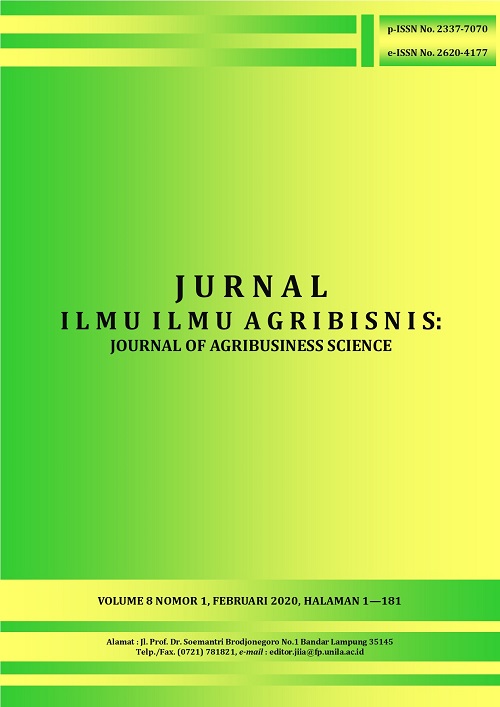ANALISIS PENDAPATAN DAN TINGKAT KESEJAHTERAAN RUMAH TANGGA PETANI NANAS DI DESA ASTOMULYO KECAMATAN PUNGGUR KABUPATEN LAMPUNG TENGAH
DOI:
https://doi.org/10.23960/jiia.v8i1.4337 Abstract View: 685
Abstract View: 685
Abstract
This research aims to analyze pineapple farming income, household income, and the prosperity grade of pineapple farmer’s household in Astomulyo Village. This research was purposively conducted in FebruaryMarch 2019 at Astomulyo Village, Punggur Sub District, Central Lampung Regency by survey method. There are 63 respondents taken by Simple Random Sampling. The data was analyzed quantitative and qualitative by farming income method (R/C ratio), household income based on the criteria of BPS (2016), and the welfare level of farmer’s household based on the criteria of BPS (2014). The results showed that average income of pineapple farmers based on cash cost and total cost per hectare wasRp46.526.933,00/year and Rp29.502.072,00/year. Pineapple farming was beneficial because it gained acceptance ratio with cash cost and total cost more than one (R/C ratio) as 3.33 and 1.80. The household income of pineapple farmers was categorized as high income for it reached Rp4.000.000,00/month until Rp6.000.000,00/month. The most contributed income was derived from pineapple farming activities (66.49%), the others were from off farming (13.74%), non-pineapple on farming (12.39%), and nonfarming activities (7.37%). Based on BPS criteria, 50.79% pineapple farmers household in Astomulyo Village were categorized in not prosperous and 49.21% as prosperous farmers household.
Key words: household income, pineapple, prosperity grade
Downloads
Downloads
Published
How to Cite
Issue
Section
License
Authors who publish with this journal agree to the following terms:
Authors retain copyright and grant the journal right of first publication with the work simultaneously licensed under a Creative Commons Attribution License that allows others to share the work with an acknowledgement of the work's authorship and initial publication in this journal.
Authors are able to enter into separate, additional contractual arrangements for the non-exclusive distribution of the journal's published version of the work (e.g., post it to an institutional repository or publish it in a book), with an acknowledgement of its initial publication in this journal.
Authors are permitted and encouraged to post their work online (e.g., in institutional repositories or on their website) prior to and during the submission process, as it can lead to productive exchanges, as well as earlier and greater citation of published work (See The Effect of Open Access).














